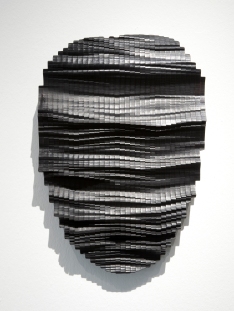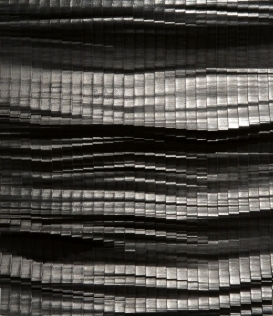This week’s guest post comes from Marco Cianfanelli, a South African artist who, in addition to participating in the Earth Matters exhibition in Washington DC, is internationally recognized. Cianfanelli is an artist who examines the universal within the personal and, as the great T.S. Eliot once said of great writers, writes both himself and his time.
Back down to Earth
by Marco Cianfanelli

Maquette: The sum of us [The sum of us (2009) realised at 4.44 x 3.47 x 11.4 meters; mild steel: Forum Homini, Cradle of Humankind]
I am always slightly puzzled when asked to give my opinion on a matter, as one of the significant reasons I became an artist is the very privilege it affords me in blurring and manipulating elements of intellect, science, knowledge, emotion & gesture in a way that is based on, but not confined to, logic or fact but in a way that makes perfect sense to me.
Is it feasible to personify the whole of humanity, as one single being, a being with particular traits and a complex yet distinct personality? Could these traits and this personality be better understood by observing the condition of the earth, how humanity exists on it, in it, with it? In this sense, our perception of the earth’s state(s) would not be a judgement of humanity but rather a reflection of it. Be it good or bad, it is what it is.
If you believe in evolution, you have to consider that we, alongside everything around us, are evolving with every passing second. Evolution is not an event it is a process. With regard to our place on earth, how are we evolving or how will we evolve in the future? Is it possible that we can be active, rather than passive in the process of our evolution and if so, will the nature in which we cohabit the earth be something we value?
Regarding evolution, Vredefort to Sterkfontein, is a work that I produced as a response to the immense significance and connectedness of the two regions of Vredefort, the site of the largest verified asteroid impact crater, and Sterkfontein, a site of significant Hominid findings, which lies within the “Cradle of Humankind”. The work is both a scientific analysis and a family portrait of sorts or a musing on the subject of genetics, created by morphing and interpolating three silhouette portraits of my mother, myself and my father, to create the seven profiles in the work. Geographic coordinates of the region between Vredefort and Sterkfontein, recorded at 20-meter intervals, were gathered to create a digital three-dimensional topographical portion of this region. This data was used to create the third dimension of the seven forms and was amplified to varying degrees on each of the seven portraits, enhancing the effect of a wave or tide, representing the immense impact that rippled the earth’s surface well beyond the region of Sterkfontein.
Could an event so dramatic and in some ways, so violent that it made the earth’s surface twist and distort like water, be intrinsic to the evolution and formation of humanity, could our dawn have been catalyzed by such a cataclysmic event? It became apparent to me that the intended “family portrait” was actually something broader and spoke to me of humanity’s connectedness.



Vredefort to Sterkfontein (I-VII)
Laser cut, burnt, laminated supawood
43 x 31 x 6.5 cm each
2009











